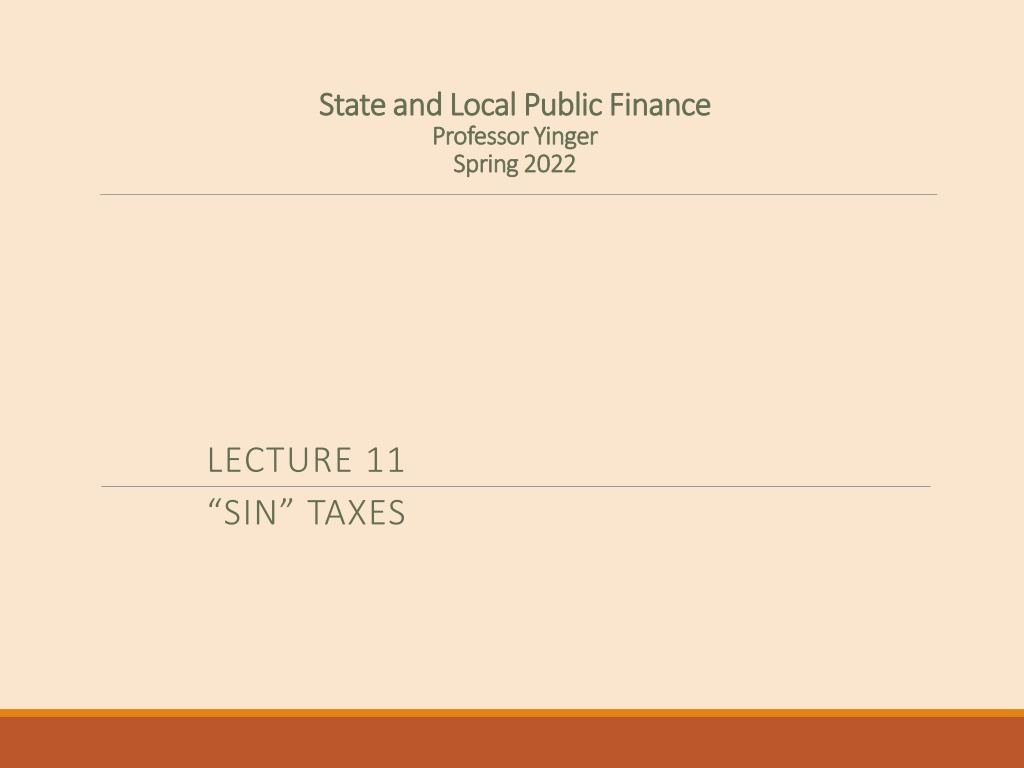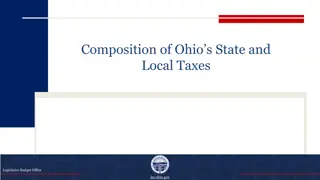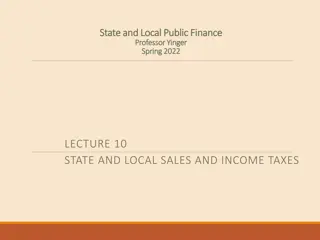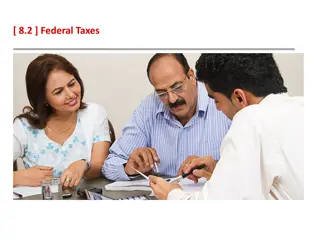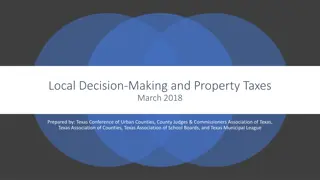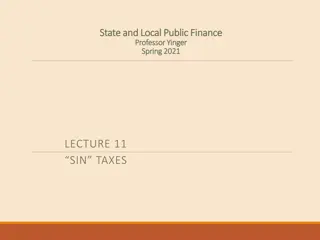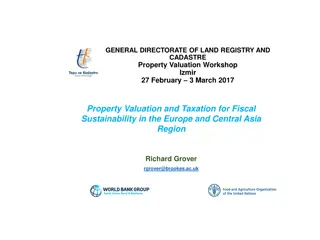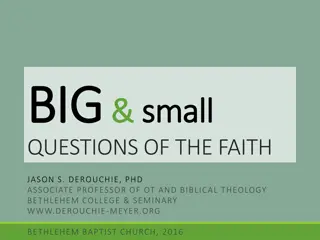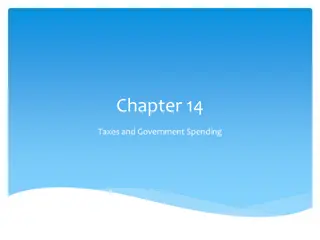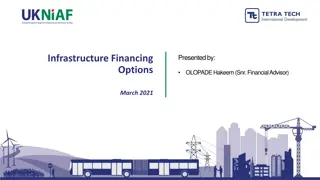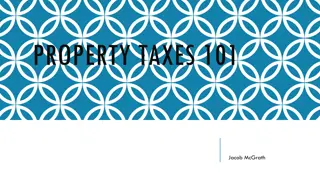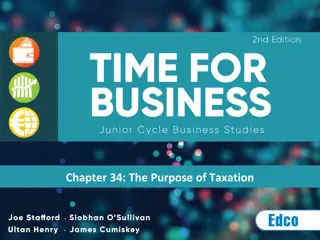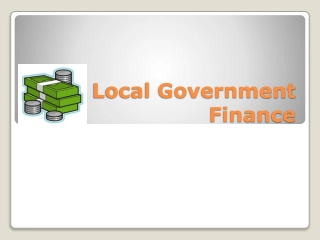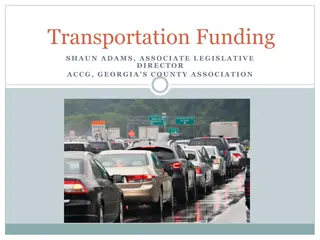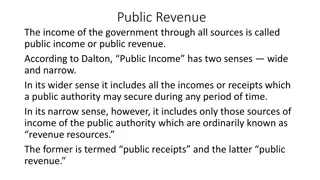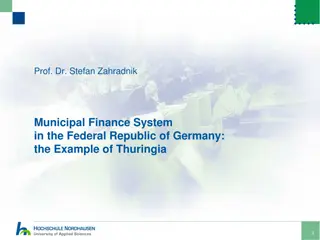Understanding Sin Taxes in State and Local Public Finance
Sin taxes are levied on products with negative externalities, such as alcohol, tobacco, and gambling. While they generate revenue and aim to discourage consumption, their long-term revenue potential is limited. Policy changes may be needed to strengthen sin tax revenue growth and prevent tax evasion. This lecture explores the concept of sin taxes and their implications on government finances.
Download Presentation

Please find below an Image/Link to download the presentation.
The content on the website is provided AS IS for your information and personal use only. It may not be sold, licensed, or shared on other websites without obtaining consent from the author. Download presentation by click this link. If you encounter any issues during the download, it is possible that the publisher has removed the file from their server.
E N D
Presentation Transcript
State and Local Public Finance State and Local Public Finance Professor Yinger Professor Yinger Spring 2022 Spring 2022 LECTURE 11 SIN TAXES
State and Local Public Finance State and Local Public Finance Lecture 11: Sin Taxes Lecture 11: Sin Taxes Class Outline What Are Sin Taxes? General Analysis of Sin Taxes Three Examples oLotteries oSports Gambling oMarijuana Taxes
State and Local Public Finance State and Local Public Finance Lecture 11: Sin Taxes Lecture 11: Sin Taxes Class Outline What Are Sin Taxes? General Analysis of Sin Taxes Three Examples oLotteries oSports Gambling oMarijuana Taxes
State and Local Public Finance State and Local Public Finance Lecture 11: Sin Taxes Lecture 11: Sin Taxes What Are Sin Taxes? Sin taxes are taxes on products that are thought to have not only benefits to the people who use them but also significant negative externalities for society. Excess alcohol causes disease and traffic deaths. Smoking causes diseases and affects longevity. Gambling can lead to income loss and even addiction. Sin taxes are seen by some as free revenue because people choose to buy the associated products.
State and Local Public Finance State and Local Public Finance Lecture 11: Sin Taxes Lecture 11: Sin Taxes What Are Sin Taxes? 2 For the latest developments, including revenue totals, on various sin taxes, see Dadayan, National Tax Journal, December 2019. Her conclusion is that: sin taxes offer only limited revenue potential to governments. Greater dependence on sin tax revenues can also set up odd incentives, as part of the reason for taxing some of these activities is to discourage consumption and use, not to maximize revenue . Taxing sins is understandably appealing to officials wishing to raise revenue without raising taxes on income or sales, but the longer-term revenue picture is uncertain.
State and Local Public Finance State and Local Public Finance Lecture 11: Sin Taxes Lecture 11: Sin Taxes What Are Sin Taxes? 3 Dadayan also points out that The longer-term growth patterns for sin tax revenue have often been weak and limited, absent policy changes such as increased tax rates. Even in states where there has been growth in sin tax revenues, these revenues often make up only a small part of state budgets . Further, higher tax rates can decrease consumption, which lowers tax revenue. In addition, tax rate increases on these products may also lead to shifts in consumer behavior, consumption of alternative products, and tax evasion through smuggling from nearby jurisdictions.
State and Local Public Finance State and Local Public Finance Lecture 11: Sin Taxes Lecture 11: Sin Taxes What Are Sin Taxes? 4 Broadly speaking, sin taxes fall into two categories: Explicit or implicit sales taxes levied at the point of sale for goods or services considered to be sins. This category includes explicit taxes on alcohol and tobacco and implicit taxes on lottery tickets. Income taxes on income obtained through gambling.
State and Local Public Finance State and Local Public Finance Lecture 11: Sin Taxes Lecture 11: Sin Taxes Class Outline What Are Sin Taxes? General Analysis of Sin Taxes Three Examples oLotteries oSports Gambling oMarijuana Taxes
State and Local Public Finance State and Local Public Finance Lecture 11: Sin Taxes Lecture 11: Sin Taxes Sin Tax Distortion One reason sin taxes at the point of sale are popular is they often involve relatively little distortion. Recall that tax distortion depends on the price elasticity of demand. Distortion is smaller when the price elasticity is smaller that is, when behavior changes relatively little when the tax is imposed. Some sin taxes therefore have little distortion because they apply to addictive products, such as cigarettes, with a low price elasticity. Other sin taxes (e.g., on soda?) may involve more distortion. Recall the following figure:
State and Local Public Finance State and Local Public Finance Lecture 11: Sin Taxes Lecture 11: Sin Taxes Excess Burden and the Price Elasticity of Demand Why excess burden increases with the absolute value of the demand elasticity: P P P2 P2 S+t S+t P1 S D P1 S D Q Q Q Q Q Q Q 2 1 2 1 Large elasticity ( e ) = Responsive Demand Small Elasticity ( e ) = Unresponsive Demand
State and Local Public Finance State and Local Public Finance Lecture 11: Sin Taxes Lecture 11: Sin Taxes Sin Tax Distortion, 2 Sin taxes may also impose minimal if any distortion because, to some degree, they offset an externality. The externality varies, of course, from case to case, and may not be sufficient to offset low price elasticities or other factors. For example, cigarette smokers impose a cost on other people because they need more health care. But cigarette smokers also may subsidize other people s retirement funds (at least with defined benefit plans, such as social security) because they do not live as long. Recall the following figure:
State and Local Public Finance State and Local Public Finance Lecture 11: Sin Taxes Lecture 11: Sin Taxes Excess Burden with an Externality Tax to Offset Externality Government Revenue P PMC = Private marginal cost Excess Burden Avoided with Tax = SMC P2 SMC = Social marginal cost S + Tax = PMC + SMC P = t P1 S = PMC Q D Q2 Q1 Q Q The Market for Taxed Goods
State and Local Public Finance State and Local Public Finance Lecture 11: Sin Taxes Lecture 11: Sin Taxes The Incidence of Sin Taxes The supply curves for most of the goods covered by sin taxes appear to be very elastic. The implication is that consumers bear most of the burden of these taxes. Recall the following diagram:
State and Local Public Finance State and Local Public Finance Lecture 11: Sin Taxes Lecture 11: Sin Taxes Sin Tax Incidence, 2 P P2 S+tax P1=P3 S D Q Many goods have elastic supply curves, so most of the burden of sales tax differences falls on consumers.
State and Local Public Finance State and Local Public Finance Lecture 11: Sin Taxes Lecture 11: Sin Taxes Sin Tax Incidence, 3 Thus, many sin taxes are regressive. Lower-income people tend to spend a larger share of their income on alcohol, tobacco, and gambling, for example, than do higher-income people. One striking feature of sin-tax incidence, is that it varies within an income class. At any given income level, some people drink to excess, smoke, or gamble, whereas other people do not.
State and Local Public Finance State and Local Public Finance Lecture 11: Sin Taxes Lecture 11: Sin Taxes Sin Tax Incidence, Cont. T Y Progressive Proportional Regressive Y
State and Local Public Finance State and Local Public Finance Lecture 11: Sin Taxes Lecture 11: Sin Taxes Special Issues for Sin Taxes Alcohol taxes have the disadvantage compared to state liquor store prices that they cannot be imposed on nonresidents. The relationship between cigarettes and e-cigarettes is not clear. Do e-cigarettes boost addiction or provide a way off of cigarettes? Casinos may involve intense competition across states. How addictive are the slot machines in casinos, which now exist in 39 states? Can soda taxes make an impact on obesity?
State and Local Public Finance State and Local Public Finance Lecture 11: Sin Taxes Lecture 11: Sin Taxes Taxes on Income from Gambling Small winnings may be tax-exempt, but roughly speaking, taxpayers owe federal, state, and local income taxes on winnings from gambling. They may also be able to deduct gambling losses. These taxes are also very regressive, because low-income people are more likely to gamble (and hence to have winnings). These taxes also fall on only a subset of people in a given income class.
State and Local Public Finance State and Local Public Finance Lecture 11: Sin Taxes Lecture 11: Sin Taxes Class Outline What Are Sin Taxes? General Analysis of Sin Taxes Three Examples oLotteries oSports Gambling oMarijuana Taxes
State and Local Public Finance State and Local Public Finance Lecture 10: Revenue from Government Monopoly Lecture 10: Revenue from Government Monopoly State-Run Lotteries The first state lottery was in New Hampshire in 1964. Now 45 states have a lottery. In FY 2017, lotteries raised about 1.5% of general state revenue in the average state. Lotteries probably are a natural monopoly, as customers are attracted to very large prizes. For more on lotteries, see http://rockinst.org/wp-content/uploads/2017/11/2016-04-12- Blinken_Report_Three-min.pdf
State and Local Public Finance State and Local Public Finance Lecture 10: Revenue from Government Monopoly Lecture 10: Revenue from Government Monopoly Policy Issues Raised By Lotteries 1. Legalization (Should lottery gambling be allowed?) 2. Government Provision (Should lotteries be a private or government monopoly?) 3. Rate of Taxation (How much revenue should the state claim?) 4. Earmarking (Should the revenue be earmarked for education?) 5. Promotion (How should lotteries be designed and advertised?)
State and Local Public Finance State and Local Public Finance Lecture 10: Revenue from Government Monopoly Lecture 10: Revenue from Government Monopoly Legalization Lotteries generate consumer surplus, that is, many people pay for their entertainment value. Lotteries also generate social costs: gambling addiction for some people, increased crime, and, perhaps, undermining incentives to earn one s way. There is a consensus in this country that the benefits outweigh the costs (although the costs are high).
State and Local Public Finance State and Local Public Finance Lecture 10: Revenue from Government Monopoly Lecture 10: Revenue from Government Monopoly Government Provision Lotteries require large scale, so private lotteries would be huge companies that would be: o Difficult to regulate and tax (think of their political connections!) o Inviting to criminal elements. Thus, there is a broad consensus that legalized lotteries should be government monopolies. But many states are debating private management or even the sale of the lottery to a private company.
State and Local Public Finance State and Local Public Finance Lecture 10: Revenue from Government Monopoly Lecture 10: Revenue from Government Monopoly Government Provision, 2 In January 2011, Illinois turned the management of its lottery over to a private firm. Indiana and New Jersey have also gone this route. In Illinois, the firm agreed to large payments to the state if it does not increase lottery revenue. Without comprehensive contracts, this approach is a recipe for exploitation. See http://www.forbes.com/sites/realspin/2015/02/24/where-lottery-privatization- went-wrong/#466a94214f18 . https://www.world-lotteries.org/media-news/member-news/2848-illinois- lottery-reports-record-breaking-sales-for-october . https://www.northjersey.com/story/news/new-jersey/2019/05/14/nj-lottery- deal-northstar-new-jersey-save-taxpayers-100-m/3663943002/
State and Local Public Finance State and Local Public Finance Lecture 10: Revenue from Government Monopoly Lecture 10: Revenue from Government Monopoly Rate of Taxation Lotteries provide a classic example of the trade-off between CS and revenue: o The analytical case for lotteries is based on the CS they generate, which is minimized by low implicit tax rates. o The political case for lotteries is based on the money they raise, which is maximized by high implicit tax rate.
State and Local Public Finance State and Local Public Finance Lecture 10: Revenue from Government Monopoly Lecture 10: Revenue from Government Monopoly Rate of Taxation, 2 In this case (as in many others!) politics wins, that is, the implicit tax rates are very high. What is the implicit tax rate? o Answer: What the state keeps divided by the total costs of running the lottery. o Let t= implicit tax rate, R = state revenue, P = prizes awarded, C = administrative costs. R + = t Then P C
State and Local Public Finance State and Local Public Finance Lecture 10: Revenue from Government Monopoly Lecture 10: Revenue from Government Monopoly Rate of Taxation, 3 According to the Census, the values of these variables for the U.S. as a whole in 2016 (per $1.00 of sales) are: o R = $0.315 o P = $0.640 o C = $0.045. Thus, the average implicit tax rate in the U.S. in 2016 was: 0.315 0.640 0.045 + t = = = 0.461 46.1% This is analogous to a sales tax rate.
State and Local Public Finance State and Local Public Finance Lecture 10: Revenue from Government Monopoly Lecture 10: Revenue from Government Monopoly Rate of Taxation, 4 This is not a typo: The tax rate in the typical state was 46.1%! In 2016, implicit lottery tax rates range from 16% (Idaho) to 288% (South Dakota) and are all far higher than the rates for any other type of sales tax. These high rates of tax cause enormous distortion between lotteries and other types of commodities. But they also cut back on the social costs (externalities) of lotteries and export taxes to nonresidents.
Implicit Lottery Tax Rates, 2016 26.8% Arkansas 25.6% California 46.1% Colorado 34.6% Connecticut 44.4% Delaware 150.6% Florida 42.0% Georgia 37.5% Idaho 16.0% Illinois 33.6% Indiana 33.1% Iowa 31.8% Kansas 40.1% Kentucky 38.2% Louisiana 59.2% Maine 49.3% Maryland 43.9% Massachusetts 32.7% Michigan 42.6% Minnesota 36.5% Missouri 37.1% Montana 47.9% 35.1% 37.6% 47.1% 45.1% 66.2% 39.8% 40.0% 42.6% 57.6% 192.3% 42.2% 213.8% 36.9% 288.1% 66.8% 41.3% 29.5% 45.3% 37.8% 85.7% 49.3% 23.9% Arizona Nebraska New Hampshire New Jersey New Mexico New York North Carolina North Dakota Ohio Oklahoma Oregon Pennsylvania Rhode Island South Carolina South Dakota Tennessee Texas Vermont Virginia Washington West Virginia Wisconsin Wyoming Source: U.S. Census
State and Local Public Finance State and Local Public Finance Lecture 10: Revenue from Government Monopoly Lecture 10: Revenue from Government Monopoly Rate of Taxation, 5 Moreover, lottery taxes are very regressive far more regressive than any other revenue source. One study: Low-income individuals earn 11% of total income but provide 25% of lottery revenue. Some games, such as instant games and lotto, are particularly regressive. Within income classes, the burden of lotteries is concentrated on a relatively small share of individuals.
State and Local Public Finance State and Local Public Finance Lecture 10: Revenue from Government Monopoly Lecture 10: Revenue from Government Monopoly Earmarking Almost half of lottery states earmark the funds for education. This link is part of their political appeal: Whatever their bad features, at least lotteries help fund our education system! It is not clear, however, that lotteries increase net funds for education: o They facilitate cuts in state education aid; o They lower sales tax revenue. Even counting benefits from education, lotteries are still regressive.
State and Local Public Finance State and Local Public Finance Lecture 10: Revenue from Government Monopoly Lecture 10: Revenue from Government Monopoly Earmarking, 2 For recent evidence on this issue see: Bell, Wehde, and Stucky (Education Finance and Policy, Winter 2020), who find that lottery earmark policies are associated with a 5 percent increase in higher education appropriations, and a 135 percent increase in merit-based financial aid. However, lottery earmarks are also associated with a decrease in need-based financial aid of approximately 12 percent. An accessible summary of this article can be found at: https://www.brookings.edu/blog/brown-center- chalkboard/2018/05/09/who-wins-and-who-loses-when-states-earmark- lottery-revenue-for-higher-education/
State and Local Public Finance State and Local Public Finance Lecture 10: Revenue from Government Monopoly Lecture 10: Revenue from Government Monopoly Promotion, 1 The people who run lotteries are paid to raise as much money as possible. Hence, they resort to aggressive advertising: All you need is a dollar and a dream. Some of this advertising is misleading at best, with no recognition of the low odds of winning. Moreover, this advertising puts government in the position of undermining the work ethic.
State and Local Public Finance State and Local Public Finance Lecture 10: Revenue from Government Monopoly Lecture 10: Revenue from Government Monopoly Promotion, 2 The people who run lotteries sometimes resort to promoting games that are directed toward low-income communities. o These games maximize revenue because these people are more vulnerable to the misleading appeal of instant wealth. o But they also maximize both the regressivity of the lottery tax and the social costs of lottery addiction. Promotions of this type are, in my view, simply unethical.
State and Local Public Finance State and Local Public Finance Lecture 10: Revenue from Government Monopoly Lecture 10: Revenue from Government Monopoly Conclusions About Lotteries Lotteries are here to stay. States cannot get rid of them without losing revenue to their neighbors. High implicit taxes discourage participation and cut direct CS but also cut the social costs. So keep lotteries with high rates but use honest advertising and do not target vulnerable groups or use highly addictive games.
State and Local Public Finance State and Local Public Finance Lecture 11: Sin Taxes Lecture 11: Sin Taxes Sports Gambling In May 2018, the Supreme Court overturned the Professional and Amateur Sports Protection Act, clearing the way for sports betting outside Nevada. Seven states adopted sports wagering legislation by year s end: New Jersey, Delaware, Mississippi, New Mexico, Pennsylvania, Rhode Island and West Virginia. According to the American Gaming Association, the expansion helped the sports gaming market grow revenue nearly 65% year over year to $430.2 million. And in 2019, the AGA said data through April showed a 175% increase in revenue from sports betting over 2018. Source: https://www.cnbc.com/2019/06/10/sports-betting- propels-casinos-to-4th-straight-year-of-revenue-gains.html
State and Local Public Finance State and Local Public Finance Lecture 11: Sin Taxes Lecture 11: Sin Taxes Sports Gambling, 2 In the following table: Handle: Amount wagered over the time period. Revenue: Amount of money kept by sportsbooks out of the amount wagered. Hold %: How much revenue sportsbooks keep as a function of handle. Taxes/state revenue: Taxes collected by state and local jurisdictions; or state share of proceeds in revenue-sharing markets. The numbers reflect all reported numbers starting in June 2018 to indicated date. Last update: Feb. 6, 2020.
State and Local Public Finance State and Local Public Finance Lecture 11: Sin Taxes Lecture 11: Sin Taxes U.S. Sports Betting Revenue, 2018 and 2019 Handle Revenue $1,229,693,083 $189,620,187 $24,465,853 $435,998,645 $42,758,939 $212,225,668 $19,283,689 $526,313,244 $59,627,039 $8,340,376,488 $522,968,000 $5,830,205,870 $393,420,427 -- $45,067,568 $1,507,754,787 $114,248,501 $227,911,697 $276,270,297 Hold 7.00% 12.90% 9.80% 9.10% 11.30% 6.30% 6.70% Taxes/State Rev. $155,684,758 $10,703,811 $4,062,099 $1,301,649 $7,155,245 $35,300,340 $51,778,548 $778,343 $2,514,785 $31,186,640 $8,295,583 $2,607,715 State Total Delaware Indiana Iowa Mississippi Nevada New Jersey New York* Oregon Pennsylvania Rhode Island West Virginia Sports Gambling, 3 $17,591,744,451 $7,783,426 $2,794,206 -- 6.20% 7.60% 7.10% 9.40% $16,265,849 $26,077,153 *New options are available for sports betting in New York as of January 2022.
State and Local Public Finance State and Local Public Finance Lecture 11: Sin Taxes Lecture 11: Sin Taxes Sports Gambling, 3 But the legal industry still has a mighty challenge in the form of illegal sports wagering. Legal and regulated sports betting barely scratched the surface of an entrenched black market comprised of offshore sportsbooks and street bookies, the AGA said. It estimates this market accounts for $150 billion in annual bets.
State and Local Public Finance State and Local Public Finance Lecture 11: Sin Taxes Lecture 11: Sin Taxes Tax Implementation Questions Remember the set of questions for a lottery: 1. Legalization (Should the behavior be allowed?) 2. Government Provision (Should the market be public or private?) 3. Rate of Taxation (How much revenue should the state claim?) 4. Earmarking (Should the revenue be earmarked?) 5. Promotion (Should promotion be regulated?)
State and Local Public Finance State and Local Public Finance Lecture 11: Sin Taxes Lecture 11: Sin Taxes Taxes on Marijuana Until recently, marijuana was illegal according to both state and federal law. This situation has changed dramatically in the last few years. See the chart on the next page. Marijuana sales and consumption are still illegal under federal law, although a truce is now in place under which the federal government has agreed not to work against state laws.
State and Local Public Finance State and Local Public Finance Lecture 11: Sin Taxes Lecture 11: Sin Taxes Marijuana Laws as of March 2021 (disa.com)
State and Local Public Finance State and Local Public Finance Lecture 11: Sin Taxes Lecture 11: Sin Taxes Marijuana Legalization (Becker, Politico, 10/14/2019) Advocates for legalization in California originally envisioned legalized pot raising $1 billion a year. As it turns out, the state raised not even a third of that in fiscal 2018-19, the first full year since recreational sales began. Massachusetts had projected it would bring in $63 million in revenue for its first year of recreational pot, which ended in June, and didn t even get half of that. It s not just that states have struggled in projecting the size of a legal marijuana market and deciding how to best tax and regulate it. In a lot of ways, states are also grappling with their central goal of bringing cannabis out of the black market.
State and Local Public Finance State and Local Public Finance Lecture 11: Sin Taxes Lecture 11: Sin Taxes Marijuana Taxes (Pew Charitable Trusts)
State and Local Public Finance State and Local Public Finance Lecture 11: Sin Taxes Lecture 11: Sin Taxes Marijuana Legalization: Unusual Issues It is difficult to forecast revenue. Response to income changes is not yet understood. Norms concerning consumption are evolving. New products, such as oils and edibles, are emerging. The role of (untaxed) medical marijuana is hard to forecast, too. It is difficult to set tax rates and license fees. Impact of taxes on consumption is not yet known. Impact of taxes and fees on sellers is not yet known. Will they create monopolies? Revenue may be very volatile, especially in the medium term as the legal markets are forming.
State and Local Public Finance State and Local Public Finance Lecture 11: Sin Taxes Lecture 11: Sin Taxes Marijuana Legalization: Unusual Issues, 2 The costs and benefits are not well known yet. Many people enjoy marijuana products, but how much are they willing to pay? What are the costs and benefits to society? Less productive workers? (Measured how?) More traffic accidents? (Some studies count the number of traffic accidents in which a driver tested positive for marijuana, but these studies cannot determine whether marijuana was the cause of an accident and neither can a police officer.)
State and Local Public Finance State and Local Public Finance Lecture 11: Sin Taxes Lecture 11: Sin Taxes Marijuana Legalization: Unusual Issues, 3 Because marijuana is easy and cheap to grow, legal sellers face strong competition from the black market. The black market does not have to pay taxes or license fees Or pay to test quality control. But, of course, black-market firms risk being caught (and states must devise penalties and enforcement strategies). Legal markets take time to be up and running. The black market is already operating. There is a trade-off between lowering prices to out-compete black market firms and raising prices to raise more revenue (assuming inelastic demand) or to discourage consumption.
State and Local Public Finance State and Local Public Finance Lecture 11: Sin Taxes Lecture 11: Sin Taxes Marijuana Legalization: Unusual Issues, 4 Some states may benefit from marijuana tourism. This seems to be happening in Alaska, Colorado, and Nevada. Some neighboring states (Massachusetts and Vermont? West Coast?) may compete for marijuana sales. It seems unlikely that this competition will be as strong as in the case of lotteries at least not for a while. Many states are decriminalizing marijuana use, but do not appear likely to legalize sales.
State and Local Public Finance State and Local Public Finance Lecture 11: Sin Taxes Lecture 11: Sin Taxes Marijuana Taxes (Pew Charitable Trusts) Recreational cannabis products have diversified beyond the raw, cut plant to include oils, extracts, and edibles the popularity of which has varied by state. In Washington, for example, consumption has shifted toward extracts, but Colorado has seen strong growth in concentrates and edibles. Just as forecasters consider changing demands for beer, wine, and spirits when projecting revenue from alcohol taxes, they are trying to do so with marijuana. But given how new these products are, analysts have little available data with which to gauge trends. Another challenging calculation is to what extent and how quickly consumers will transition from the black market to the legal one. Forecasters note that legal market prices tend to be higher because licensed businesses must pay taxes, fees, and the cost of testing to ensure consumer safety. The California Cannabis Advisory Committee, for example, found that the state s legal marijuana market does not present an attractive alternative to the black market, in large part due to higher prices. Not knowing how to account for the competition with the black market may be one reason why California s legal market hasn t met revenue expectations.
State and Local Public Finance State and Local Public Finance Lecture 11: Sin Taxes Lecture 11: Sin Taxes Marijuana Taxes (Pew Charitable Trusts) Other complications when trying to gauge collections are competition from neighboring states and the slice of revenue generated by visitors. In tourism-heavy Alaska and Nevada, sightseers contribute to surging recreational marijuana sales. Alaska s capital, Juneau, welcomes multiple cruise ships each day and has three recreational marijuana stores. But the state still needs more data showing to what extent tourists will drive future revenue growth from this new product. Nevada s Porter said revenue data so far indicate that higher-than-anticipated visitor demand contributed to collections for the first fiscal year exceeding forecasts. Colorado s Larson Silbaugh noted that his state does not anticipate much competition across state borders because the region s large cities are spread out and neighboring states are unlikely to legalize. On the other hand, Oregon and Washington likely have competing markets, especially because Washington s retail operations were up and running first. States such as Massachusetts and Vermont may also need to consider cross-border issues.
